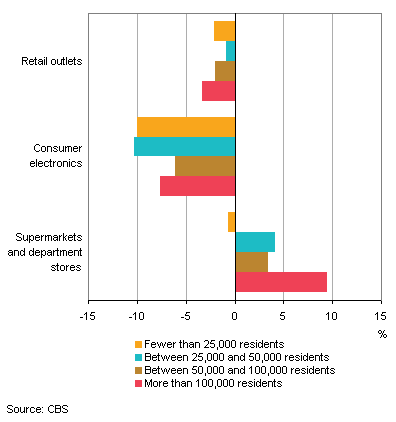More supermarkets and department stores in large municipalities

The number of supermarkets and department stores grew substantially in large municipalities in the Netherlands between 2008 and 2013, but declined in the smallest municipalities. Consumer electronics shops closed down almost everywhere, in particular in smaller municipalities.
Change in shops per resident by size class of the municipality

Shop density down
Last year, there were nearly 570 shops per 100 thousand residents in the Netherlands, i.e. 2 percent down from 2008. The relative number of shops varies significantly in Dutch municipalities. In the province of Flevoland, the rate has been low for years, but the relative number of shops in Flevoland increased by 11 percent over the period 2008–2013. In the municipality of Lelystad, the number of shops grew remarkably from 450 to 540 per 100 thousand residents in 2013. In the municipalities of Loppersum (Groningen) and Muiden, the relative number of shops also grew rapidly. In these two municipalities, the number of shops increased although the population decreased.
On the West Frisian Islands and in the municipality of Sluis (Zeeland), the number of shops per resident is at least twice as high as the national average. A wide range of shops are found to comply with the needs of local population and tourists alike. Supermarkets in particular are well represented.
Shop density, 2008-2013

Ratio of shops to residents still low in Almere
With 355 shops per 100 thousand residents, Almere was still lagging behind in 2013, although the number of supermarkets and department stores is growing more rapidly than anywhere else in the Netherlands, i.e. by more than 50 percent. In the municipality of Hilversum, the number of supermarkets and department stores per resident was reduced by 16 percent over the period 2008-2013. The reduction is the result of closedowns and a growing population.
Fewer consumer electronics shops
The number of consumer electronics shops per resident was reduced by more than 8 percent over the period 2008–2013. The reduction is on a par with the growth of the number of mail-order and internet businesses. The most substantial reduction (10 percent) occurred in smaller municipalities.
The relative number of department stores and supermarkets has increased notably, by 5 percent on average, but in this case too, the size of the municipality is an important factor. Larger municipalities show a growth rate by nearly 10 percent; in the smallest municipalities, the number of department stores and supermarkets was reduced marginally.
Supermarkets and department stores, municipalities with more than 50 thousand residents, 2008-2013

Mieke Mateboer, Hub Beunen and Gusta van Gessel